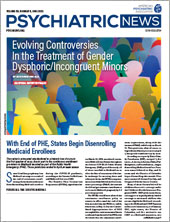When PGY-2 residents at my psychiatry residency program take evening call shifts, we are the lone physicians on call who have to juggle a lot of responsibilities—handling admissions and discharges, managing the inpatient floors with up to 60 patients, and providing consultation-liaison services. During my first night shift, I admitted a 13-year-old girl who presented with suicidal ideation for the second time in less than a month after feeling unsupported by her parents and siblings in her gender identity.
She was assigned male sex at birth, but she identified as girl, and as she approached adolescence, she began to share her gender identity with her loved ones. Sadly, this self-disclosure was met with disapproval and antagonism by her family. Her parents turned to religious interventions to make her “change back into a boy,” isolated her from friends, and homeschooled her while they searched for a religious school for full-time placement. Over time, she grew increasingly depressed, anxious, and, eventually suicidal, which led to her first hospitalization. She began an antidepressant medication, participated in a series of family meetings, and was discharged to an intensive outpatient service but to no avail, as she wound right back in the hospital just a few weeks later.
During my admission interview, she explained that any progress made in family meetings had been lost after returning home. Her antidepressant was not helping, and she started to hate herself and the body she was born in. “I was doing some reading and think this is ‘gender dysphoria,’” she shyly offered.
I returned to my workstation to write my admission note. It was very clear to me that medications and psychotherapies alone were not the primary solution, but I was just covering for the night, and the tools to address societal and structural matters were not readily available on an inpatient unit. The day team already knew her case well so I carefully documented her situation, knowing my colleagues would support and affirm her. I made sure she was settled and carried on with the rest of my shift.
Three months later, I found myself on another week of nights. I received a call about a new admission, and to my surprise, it was the same girl I had admitted in July. Only a few weeks after discharge from a two-month hospitalization, she was presenting again with suicidal ideation. She remembered me—one of the perks of being a 6-foot-7-inch-tall doctor—and explained how nothing had changed at home, that her new antidepressant wasn’t helping, and that the only place where she felt safe from being antagonized was in the hospital. On our inpatient service she had befriended other transgender and gender nonbinary teens and, for the first time in her life, had felt some semblance of normalcy despite its coming within the confines of a locked inpatient psychiatric unit.
I asked her somewhat rhetorically: “It seems to me that medications and therapies aren’t the answer, huh?” She nodded in agreement.
This young girl hospitalized three times within six months illustrates how rates of suicidal ideation, attempts, and deaths by suicide are climbing among transgender people and youth. Members of the LGBTQ+ community already face a disproportionate burden of mental illness. Within this community, transgender and gender nonbinary individuals are burdened further by being dehumanized and targeted both physically and psychosocially by their families, society, and the government. Even more harrowing, transgender and nonbinary people who are
Black, indigenous, or other
people of color face even greater challenges when factoring in antagonism against these intersectional identities.
Today,
hundreds of state bills across the country are being introduced and passed to limit the rights of transgender youth. Politicians, including governors, members of Congress, and a former U.S. president, are voicing support for these anti-trans bills with news outlets further amplifying these harmful messages. Meanwhile, portrayals of transgender people in the media are
largely negative if not missing altogether, while heavily platformed celebrities and public figures further delegitimize and propagate harmful tropes of transgender people. If bills and budgets are our society’s moral documents, then the treatment of transgender youth speaks loudly about our country’s values.
Sadly, our mental health profession has also been complicit in shaping many of the negative societal perspectives about members of the LGBTQ+ community, most notably by pathologizing identities and listing them as psychiatric or “psychosexual” disorders in the
Diagnostic and Statistical Manual. Today, our profession remains critical of its past and has since worked to not only address its history but also champion
gender-affirming care and support the livelihoods of transgender and gender nonbinary people.
June is Pride Month and serves as a reminder for psychiatrists to reinforce our year-round commitment to supporting the lives of transgender and nonbinary youth.
Members of the LGBTQ+ community have done so much to shape many of the civil liberties and positive aspects of our world, but even beyond their contributions to society, they deserve the opportunity to live lives with love and freedom of self-expression.
While our traditional roles as clinicians are important—we might represent the safest place for some young people—we should not settle for meeting people solely in our offices and emergency departments. After all, preventing illness is better than waiting to treat it. Our positionality as mental health clinicians comes with agency and influence, which allow us to advocate for transgender and nonbinary youth. That can look like partnering with APA and other organizations that work to
defend transgender civil rights; advocating legislatively at local, state, and national levels; supporting and/or providing gender-affirming care that positively impacts mental health and saves lives; and organizing at the grassroots level. A world where transgender youth feel safe and affirmed outside of clinical settings is the world we need to make a reality. ■
Resources
APA urges you to become involved with advocacy, and staff in APA’s Division of Government Relations will work with you and provide you with helpful tools. For more information, email Ashley Mild of APA’s Division of Government. Relations at
[email protected]. Keep up with APA’s advocacy work by signing up for APA’s Advocacy Alerts at
https://www.psychiatry.org/psychiatrists/advocacy.

